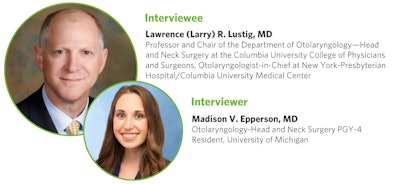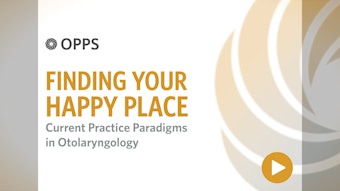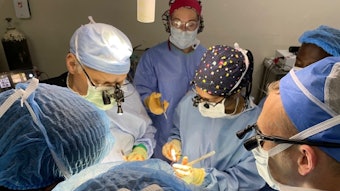Pearls from Your Peers: Gene Therapy for Hearing Loss
Madison V. Epperson, MD, interviews Lawrence (Larry) R. Lustig, MD, about gene therapy.

In this edition of “Pearls from Your Peers,” I am joined by Lawrence (Larry) R. Lustig, MD, from Columbia University and New York-Presbyterian Hospital, who explains the implications of recent advances in gene therapy for hearing loss and how clinicians can best identify candidates for treatment.
Can you explain the basics of gene therapy?
With gene therapy, you've got a genetic defect of some type leading to a loss or change of function, and the goal is to correct that loss of function. If a gene is completely turned off because of a mutation, there would be no production of the resulting protein. If you can get normal protein into the cell via a vector and shuttled to the right location, you should be able to correct the malfunction caused by the gene mutation. It is complex though; even proteins that are active throughout the rest of the body, if even slightly perturbed in the ear, can oftentimes lead to hearing loss. That's why we see many non-syndromic forms of hearing loss.
Are certain conditions more or less amenable to gene therapy? Which genes or conditions are currently being targeted?
Good targets for gene therapy include:
Conditions that have good cellular preservation. Gene therapy doesn’t regenerate cells that are damaged, it only stops the degeneration that occurs at the point in which you intervene. Delayed onset forms of progressive deafness are more attractive because there is a longer window to intervene.
Conditions due to abnormalities in cells that we can easily target with vectors. Vectors are great at targeting inner hair cells. Newer vectors are better able to target outer hair cells, but this is still difficult.
Conditions with good animal models. Right now, Otoferlin (OTOF) is the primary gene being targeted because it is an inner hair cell synaptic protein with good cellular preservation. Usher syndrome is a challenge because cellular degeneration starts very early, particularly in types one and two. Type three may be more of a possibility. Although connexin (CXN) is common, there is no good animal model because the mutations are lethal in utero. Secondly, in CXN, there is a problem with the potassium circulatory pathway, so you have to target every cell along the pathway—the hair cells and the supporting cells. If you miss any one location, potassium will build up and cause toxicity.
Recently, the Lancet published a trial describing gene therapy for an OTOF mutation with promising results.1 Does this new, successful trial have any immediate implications for ENTs in practice seeing children with hearing loss?
OTOF-related deafness probably accounts for 1% or less of genetic deafness. Still, to catch these kids, we must screen with auditory brainstorm response (ABR), not otoacoustic emissions (OAE), which will initially be normal in OTOF related deafness. Catching these kids early will allow us to intervene before outer hair cell defects develop (when OAEs become abnormal). I would recommend working with your hospital to convert over to ABR testing instead of OAEs. There are gene therapy options right now that work. Even though OTOF-related deafness is rare, all kids with hearing loss should be genetically tested. You may identify a needle in a haystack who is a candidate for this therapy.
Do you have any advice for clinicians being asked whether these exciting advances should impact whether patients proceed with current treatments for hearing loss?
If you have a child with deafness, get genetic testing. If they have OTOF-related deafness, get them enrolled in a clinical trial. If the child has a cochlear implant in only one ear, they would still be a candidate for gene therapy in the other ear. If they don't have OTOF-related deafness, then go forward with a cochlear implant. The number one predictor of outcomes is duration of deafness, so we should not delay implantation.
The phenomenon of duration of deafness applies to gene therapy outcomes as well. Theoretically, if a child with congenital profound deafness can have therapy to treat an identified genetic defect in a very short period, they should be able to achieve normal speech and language milestones and hear normally. We don't know if it's the same timeframe as with cochlear implants because hearing is a little bit different with the implant.
Where do you see cochlear gene therapy in 10 years?
Now that we’ve got a potential gene therapy treatment, it will drive universal genetic testing in newborns with hearing loss. This will allow for longitudinal studies with large groups of patients and a better understanding of the genotype/phenotype correlation. In 10 years, there may be one or two forms of genetic deafness that will be open for possible trials, maybe even more. As we get better at this, we’ll understand what works well, what doesn't work, what needs to be changed, and expand it to other forms of genetic deafness. The possibilities for treatment are only going to grow.
Gene therapy is very exciting because as great as cochlear implants are, they only do so much. Having a cochlear implant is better than not hearing, but it's not the same as hearing normally. For instance, there are issues with music appreciation in some cochlear implant recipients. Having sounds coming in naturally is infinitely preferable, and gene therapy offers this.
References
- Lv J, Wang H, Cheng X, Chen Y, Wang D, Zhang L, Cao Q, Tang H, Hu S, Gao K, Xun M, Wang J, Wang Z, Zhu B, Cui C, Gao Z, Guo L, Yu S, Jiang L, Yin Y, Zhang J, Chen B, Wang W, Chai R, Chen ZY, Li H, Shu Y. AAV1-hOTOF gene therapy for autosomal recessive deafness 9: a single-arm trial. Lancet. 2024 Jan 24:S0140-6736(23)02874-X. doi: 10.1016/S0140-6736(23)02874-X. Epub ahead of print. PMID: 38280389.










